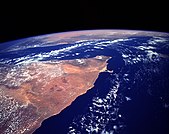Peninsula
A peninsula (from Latin paeninsula; from paene 'almost', and insula 'island') is a landform that extends from a mainland and is surrounded by water on most, but not all of its borders. A peninsula is also sometimes defined as a piece of land bordered by water on three of its sides. Peninsulas exist on all continents. The size of a peninsula can range from small to very large. The largest peninsula in the world is the Arabian Peninsula. Peninsulas form due to a variety of causes.
Etymology
Peninsula derives from Latin paeninsula, which is translated as 'peninsula'. Paeninsula itself was derived from paene 'almost', and insula 'island', or together, 'almost an island'. The word entered English in the 16th century.
Definitions
A peninsula is usually defined as a piece of land surrounded on most, but not all sides, by water, but is sometimes instead defined as a piece of land bordered by water on three of its sides.
A peninsula may be bordered by more than one body of water, and the body of water does not have to be an ocean or a sea. A piece of land on a very tight river bend or one between two rivers is sometimes said to form a peninsula, for example in the New Barbadoes Neck in New Jersey, United States. A peninsula may be connected to the mainland via an isthmus, for example, in the Isthmus of Corinth which connects to the Peloponnese peninsula.
Formation and types
Peninsulas can be formed from continental drift, glacial erosion, glacial meltwater, glacial deposition, marine sediment, marine transgressions, volcanoes, divergent boundaries or river sedimentation. More than one factor may play into the formation of a peninsula. For example, in the case of Florida, continental drift, marine sediment, and marine transgressions were all contributing factors to its shape.
Glaciers
In the case of formation from glaciers (e.g., the Antarctic Peninsula or Cape Cod), peninsulas can be created due to glacial erosion, meltwater or deposition. If erosion formed the peninsula, softer and harder rocks were present, and since the glacier only erodes softer rock, it formed a basin. This may create peninsulas, and occurred for example in the Keweenaw Peninsula.
In the case of formation from meltwater, melting glaciers deposit sediment and form moraines, which act as dams for the meltwater. This may create bodies of water that surround the land, forming peninsulas.
If deposition formed the peninsula, the peninsula was composed of sedimentary rock, which was created from a large deposit of glacial drift. The hill of drift becomes a peninsula if the hill formed near water but was still connected to the mainland, for example during the formation of Cape Cod about 23,000 years ago.
Others
In the case of formation from volcanoes, when a volcano erupts magma near water, it may form a peninsula (e.g., the Alaskan Peninsula). Peninsulas formed from volcanoes are especially common when the volcano erupts near shallow water. Marine sediment may form peninsulas by the creation of limestone. A rift peninsula may form as a result of a divergent boundary in plate tectonics (e.g. the Arabian Peninsula), while a convergent boundary may also form peninsulas (e.g. Gibraltar or the Indian subcontinent). Peninsulas can also form due to sedimentation in rivers. When a river carrying sediment flows into an ocean, the sediment is deposited, forming a delta peninsula.
Marine transgressions (changes in sea level) may form peninsulas, but also may affect existing peninsulas. For example, the water level may change, which causes a peninsula to become an island during high water levels. Similarly, wet weather causing higher water levels make peninsulas appear smaller, while dry weather make them appear larger. Sea level rise from global warming will permanently reduce the size of some peninsulas over time.
Uses
Peninsulas are noted for their use as shelter for humans and Neanderthals. The landform is advantageous because it gives hunting access to both land and sea animals. They can also serve as markers of a nation's borders.





